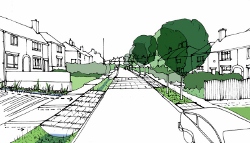- Delivering SuDS
- Using SuDS
- Background
- SuDS principles
- Benefits of SuDS
- Benefits of SuDS
- Why developers should choose SuDS
- Flood risk management
- Water quality management
- Biodiversity & ecology
- Amenity
- Air quality
- Building temperature
- Carbon reduction and sequestration
- Crime
- Economic growth
- Enabling development
- Flexible infrastructure/climate change adaptation
- Education
- Groundwater recharge
- Health and well being
- Pumping wastewater
- Rainwater harvesting
- Recreation
- Tourism
- Traffic calming
- Treating wastewater
- SuDS components
- SuDS components overview
- Source control
- Swales & conveyance channels
- Filtration
- Infiltration
- Retention & detention
- Wetlands
- Inlets, outlets and control structures
- SuDS performance & monitoring
- Delivery
- The costs & benefits of SuDS
- Adoption & maintenance of SuDS
- Legislation & regulation
- Design guidance
- Retrofitting SuDS
- Drainage exceedance
- Home
- Delivering SuDS
- Retrofitting SuDS
- Opportunities
- Identifying opportunities
Identifying opportunities
There are two main forms of retrofit opportunity. The first relates to urban regeneration or site reconstruction where the primary aim is not necessarily that of drainage improvement, but of site development, replacement or regeneration of building stock, enhanced urban environments and small local incremental improvements.
 |
 |
|
Figure 1: A typical suburban street |
Figure 2: A retrofit opportunity for a typical suburban street |
Usually, but not always, these types of opportunity occur on relatively small areas or plots of land. They can include areas of improvement as part of green network strategies. This is referred to as opportunistic retrofitting or “nibbling”.
The second opportunity to retrofit SuDS will be drainage driven, either to control flooding or pollution (or both). Such opportunities usually (but not always) occur across comparatively larger areas and may be considered to be more strategic than the opportunistic retrofitting.
Both types of opportunity may entail retrofitting across a whole area or a series of smaller “one off” retrofits.
Often opportunistic retrofitting of SuDS can be realised in addition to the primary reasons for redevelopment and other local area improvements. With strategic retrofitting aimed primarily at better surface water management it may also be relatively easy to obtain wider regeneration benefits on the back of retrofitting SuDS.
Read more on:



